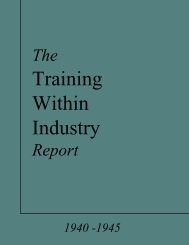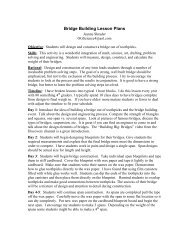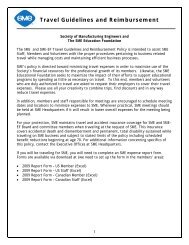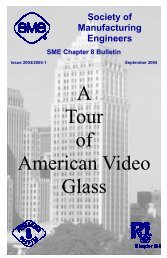Training Within Industry in the United States by Channing R. Dooley
Training Within Industry in the United States by Channing R. Dooley
Training Within Industry in the United States by Channing R. Dooley
Create successful ePaper yourself
Turn your PDF publications into a flip-book with our unique Google optimized e-Paper software.
TRAINING WITHIN INDUSTRY IN THI3 UNI'I'gD STATICS 165<br />
Such a staff person gets his management to rem<strong>in</strong>d <strong>the</strong> 1;ne organisatim<br />
from time to time that cont<strong>in</strong>u<strong>in</strong>g results are expected. He<br />
also provides technical assistance to <strong>the</strong> l<strong>in</strong>eorganisationonexactly<br />
how to use <strong>the</strong> knowledge acquired through tra<strong>in</strong><strong>in</strong>g. Analyy's of<br />
a production problem <strong>in</strong> many <strong>in</strong>stances has given a factual basis<br />
. aga<strong>in</strong>st which <strong>the</strong> tra<strong>in</strong><strong>in</strong>g can be measured.<br />
Often people are thought to be tra<strong>in</strong>ed when <strong>the</strong>y have been<br />
given certa<strong>in</strong> <strong>in</strong>formation. The use of knowledge constitutes tra<strong>in</strong><strong>in</strong>g.<br />
There must be evidence that <strong>the</strong> employee really possesses <strong>the</strong><br />
knowledge and has skill <strong>in</strong> its use.<br />
Tlce.Planl's Overall <strong>Tra<strong>in</strong><strong>in</strong>g</strong> Programme<br />
When this problem-solv<strong>in</strong>g technique is used, various tra<strong>in</strong><strong>in</strong>g<br />
needs emcrge, several perhaps com<strong>in</strong>g from every problem. <strong>With<strong>in</strong></strong><br />
<strong>the</strong> limits of facilities and time available, several k<strong>in</strong>ds of tra<strong>in</strong><strong>in</strong>g<br />
(especially if <strong>the</strong>y meet recurr<strong>in</strong>g needs of different gro,ups) can<br />
be operated at <strong>the</strong> me time. In this way <strong>the</strong> quality of workers<br />
and supervisors can be improved <strong>in</strong> <strong>the</strong> specific fields where <strong>the</strong><br />
plant needs better performance, apprentices can be prepared, staff<br />
men can be tra<strong>in</strong>ed to give better service, and leaders can be<br />
developed.<br />
The analytical approach, amounts to this: "Do no tra<strong>in</strong><strong>in</strong>g<br />
unless you have to, and <strong>the</strong>n do only what must be done to aid<br />
production". It will cut <strong>the</strong> waste of <strong>in</strong>terest<strong>in</strong>g but aimless and<br />
time-consum<strong>in</strong>g programmes and stimulate real tra<strong>in</strong><strong>in</strong>g- <strong>the</strong><br />
k<strong>in</strong>d that helps <strong>the</strong> plant to get out greater quantities of higher<br />
quality products at lower cost, and <strong>in</strong> a way that both supervisors<br />
and workers like. Obviously this does not rule out some long-range<br />
plans that build better morale and understand<strong>in</strong>g.<br />
THE T.W.1. APPROACH IN THE UNITED STATES'<br />
<strong>Tra<strong>in</strong><strong>in</strong>g</strong> <strong>With<strong>in</strong></strong> <strong>Industry</strong> was an emergency service to <strong>the</strong><br />
nation's war contractors and essential production. Its staff was<br />
drawn from <strong>in</strong>dustry to give assistance to <strong>in</strong>dustry, and its official<br />
war history covers <strong>the</strong> time from <strong>the</strong> Fall of France to <strong>the</strong> end of<br />
World War I1 - from <strong>the</strong> summer of 1940 to <strong>the</strong> autumn of 1945.<br />
T.W.I.'s objectives were to help contractors to get out better war<br />
production faster, so that <strong>the</strong> war might be shortened, and to help<br />
<strong>in</strong>dustry to lower <strong>the</strong> cost of war materials.<br />
Thero is noth<strong>in</strong>g new about T.W.I. programmes - <strong>the</strong>y are<br />
built on accepted pr<strong>in</strong>ciples. Tho only new th<strong>in</strong>g is that someth<strong>in</strong>g<br />
was done about gett<strong>in</strong>g <strong>the</strong>m used. T.W.I. soon learned that <strong>the</strong><br />
This part of <strong>the</strong> article is drawn from The <strong>Tra<strong>in</strong><strong>in</strong>g</strong> Wilh<strong>in</strong> Indus!ry Re or!,<br />
1940-1945 (Super<strong>in</strong>tendent of Documents, U.S. Government Pr<strong>in</strong>t<strong>in</strong>g 0 Ice,<br />
Wash<strong>in</strong>gton, D.C., 1945).<br />
it








